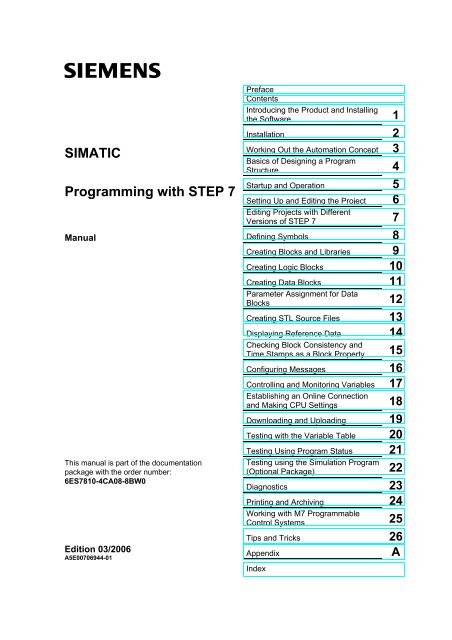

- Change byte offset db address step 7 siemens pro#
- Change byte offset db address step 7 siemens software#

DB10,S20.30.3 - Array of 3 strings at offset 20, each with length of 30 (actual array length 32 due to format of String type, length byte will be read/written).DB10,S20.30 - String at offset 20 with length of 30 (actual array length 32 due to format of String type, length byte will be read/written).DB10,INT6.2 - DB10.DBW6 and DB10.DBW8 in an array with length 2.If you use it, translator should be a function that takes a string as an argument, and returns a string in the following format: This is optional - you can choose to use "addItem" etc with absolute addresses. Sets a callback for name - address translation. The callback is called upon completion of the close. This simply terminates the TCP connection. Nodes7.dropConnection(callback) Descriptionĭisconnects from a PLC. Nodes7.initiateConnection(options, callback) DescriptionĮrr is either an error object, or undefined on successful connection. Var nodes7 = require ( 'nodes7' ) // This is the package name, if the repository is cloned you may need to require 'nodeS7' with uppercase S var conn = new nodes7 var doneReading = false var doneWriting = false var variables = API After you declare conn = new nodes7 (or similar) then add conn.doNotOptimize = true to ensure this isn't done, and don't try to request these items using array notation as this implies optimization, request REAL0 then REAL1 etc.Ĭredit to the S7 Wireshark dissector plugin for help understanding why things were not working. For this reason, normal S7 optimization must be disabled. If this parameter were an array, DB24,REAL1 would return the next in sequence even though a Siemens programmer would be tempted to use REAL4 which is not correct in this case. Basically, to address parameter number 24, output frequency for example, is defined in the documentation as a real number, so DB24,REAL0 would return the output frequency.
Change byte offset db address step 7 siemens software#
This technique can work with these drives with other software as well and is documented on the Siemens website. SINAMICS S120 and G120 FW 4.7 and up work as well, as these drives support direct connection USING SLOT 0 (instead of other examples that use 1 or 2) and some modified parameter addressing.Logo 0BA8 PLCs are supported although you should set your local and remote TSAP to match your project, and your addresses have to be specified differently.

(Note with these gateways you often have to specify the MPI address as the slot number) It is reported to work with other CPU/CP combinations as well, although not all S7-200 datatypes are supported.
Change byte offset db address step 7 siemens pro#
This has been tested on direct connections to newer PROFINET CPUs and Helmholz NetLINK PRO COMPACT and IBH units. Doing so opens up the controller for other access by other applications as well, so be aware of the security implications of doing this. In addition, you must "Enable GET/PUT Access" in the 1200/1500 controller in TIA Portal. S7-1200 and S7-1500 CPU access requires access using "Slot 1" and you must disable optimized block access (in TIA portal) for the blocks you are using. NodeS7 is written entirely in Javascript, so no compiler installation is necessary on Windows, and deployment on other platforms (ARM, etc) should be no problem. "Bad" values are returned, and eventually the connection will be automatically restored. So if the connection is lost because the PLC is powered down or disconnected, you can continue to request data with no other action necessary. So a request for 100 different bits, all close (but not necessarily completely contiguous) will be grouped in one single request to the PLC, with no additional direction from the user. It is optimized in three ways - It sorts a large number of items being requested from the PLC and decides what overall data areas to request, then it groups multiple small requests together in a single packet or number of packets up to the maximum length the PLC supports, then it sends multiple packets at once, for maximum speed. If this could injure someone or worse, consider other software. In situations where writing to a random area of memory within the PLC could cost you money, back up your data and test this really well. This software is not affiliated with Siemens in any way, nor am I. NodeS7 is a library that allows communication to S7-300/400/1200/1500 PLCs using the Siemens S7 Ethernet protocol RFC1006.


 0 kommentar(er)
0 kommentar(er)
